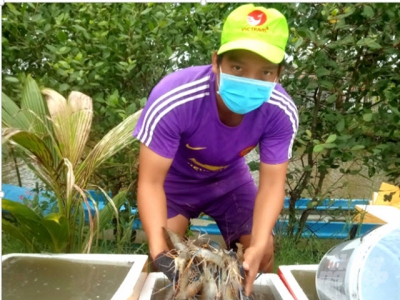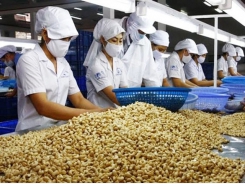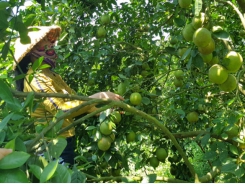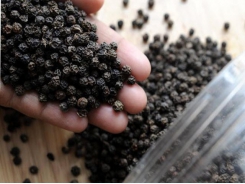Rice-shrimp farming brings benefits to farmers

The rotation between two shrimp seasons and one rice crop in Hong Dan District has proved its economic efficiency. The model raises three species of shrimps: white leg, giant tiger and giant freshwater prawns.
Giant freshwater shrimp is raised by members of Ba Dinh Cooperative. Photo: Trong Linh.
Bumper harvests of both paddy rice and shrimp
Rice-shrimp rotation is an ecological agricultural model that both adapts to climate change and brings sustainable economic efficiency. Its advantage is interrupted production that limits pathogens arising in shrimp ponds while allowing rice plants to absorb organic substances in shrimp ponds.
After years of implementing the rice-shrimp rotation model to meet the actual needs of local people in Bac Lieu Province, the model has truly upheld its sustainable economic value in recent years. Particularly, it has been successfully carried out by Ba Dinh General Agricultural Cooperative (Ben Bao Hamlet, Vinh Loc A Commune, Hong Dan District, Bac Lieu Province, which was established in 2018 with 80 members and the initial registered charter capital of VND152 million.
It is an integrated agricultural cooperative model to serve the needs of its members and the community. In addition, Ba Dinh Cooperative also links production with enterprises providing input services, provides technical support, and outputs for products of its members and farmers in the area.
“Based on the climate features of Hong Dan district, the model of 2 shrimp crops and 1 rice crop has been deployed at Hong Dan District by Ba Dinh Cooperative,” said Nong Van Thach, Director of Ba Dinh Cooperative.
“Specifically, there are 8 months of shrimp farming and 4 months of rice cultivation. Normally, shrimp seeds are released from December and by August of the following year, the ponds will be renovated to plant rice.”
Due to the influence of extreme weather, diseases on black tiger shrimp and white shrimp have become complicated; therefore, the cooperative has studied and turned to intercropping giant freshwater shrimp that has good resistance and suffers from less disease than black tiger shrimp and white shrimp.
In the model of 2 shrimp crops, giant freshwater prawn is intercropped with black tiger shrimp or giant freshwater prawns with the vannamei.
It is common to combine intercropping of giant freshwater prawns with black tiger shrimp or giant freshwater prawns with white leg shrimp. If the majority is giant freshwater shrimp, it will be mixed with white-leg shrimp or black tiger shrimp. Such a farming model will help farmers to increase their yields.
The model of two shrimp crops often combines giant freshwater prawns with black tiger shrimp or giant freshwater prawns with whiteleg shrimp.
It takes about six months to raise the giant freshwater shrimp till harvest. The species just need extra food to grow fast. For black tiger shrimp or white-leg shrimp, farmers tend to overlap with new crops. After being reared at home for about 20 days, the shrimp seeds could be ready to be scattered. Black tiger shrimp or white shrimp could be harvested from 45 to 60 days after being released while giant freshwater shrimp could continue to be fed and be harvested six months later.
After sowing rice for about 15-20 days, farmers start to release shrimp and do not use fertilizer. In case of an epidemic, biological drugs will be used in moderation so as not to affect the growth of cultured shrimp. After harvesting rice, farmers treat rice straw and continue to stock shrimp according to the process. The advantage of the rice-shrimp rotation model is the elimination of chemical fertilizers as only biological fertilizers and drugs are used to ensure clean products.
Clean products enter the supermarket
By now, Ba Dinh Cooperative has contacted a number of businesses to find ways to preliminarily process and supply shrimp to shops and supermarkets inside and outside the province.
The cooperative also undertakes the supply of inputs and outputs for the farmers.
Currently, the output for giant freshwater shrimp is difficult because the products are mainly fresh products while companies in the area are restricting purchases due to the impact of the Covid-19 pandemic. However, the cooperative still finds a way to connect with the supermarket, seeking outputs for giant freshwater shrimp.
According to the director of Nong Van Thach Cooperative, its members can sell shrimp and rice at higher prices. Overall calculated, each hectare of the rice-shrimp model could offer an income from VND60-100 million/year.
In early 2021, Ba Dinh Cooperative was supported by Vinh Loc A Commune People's Committee and Hong Dan District's Department of Agriculture and Rural Development to deploy 500 hectares of rice varieties Dai Thom 8 and OM 18. These are fragrant rice varieties with good resistance to pests and diseases. After that, the cooperative has mobilized non-members to join the chain of association.
According to Nguyen Van Thoi, Chairman of Hong Dan District People's Committee, the rice-shrimp model helps farmers earn a profit of VND60-100 million/ha/year (depending on the price).
“This is an eco-friendly model. In the coming time, Hong Dan District will continue to replicate these production models in the conversion area,” he added.
Currently, the total area of rice cultivated on shrimp area in the conversion area of Hong Dan District is more than 24,750 hectares, an increase of 1,225 hectares over the same period. The main varieties of rice cultivated include Mot Bui Do, ST24, ST25, Dai Thom 8 and hybrid rice.
The whole district has more than 25,600ha for aquaculture, an increase of nearly 130ha over the same period, in which most farmers combine shrimp farming with other aquatic products.
Related news
Tools

Phối trộn thức ăn chăn nuôi

Pha dung dịch thủy canh

Định mức cho tôm ăn

Phối trộn phân bón NPK

Xác định tỷ lệ tôm sống

Chuyển đổi đơn vị phân bón

Xác định công suất sục khí

Chuyển đổi đơn vị tôm

Tính diện tích nhà kính

Tính thể tích ao




 Poultry consumption faces difficulties, farmers reduce flock size
Poultry consumption faces difficulties, farmers reduce flock size  Turkey boosts pepper imports from Vietnam
Turkey boosts pepper imports from Vietnam